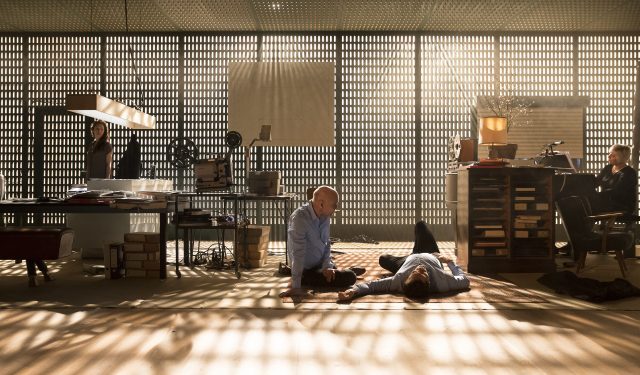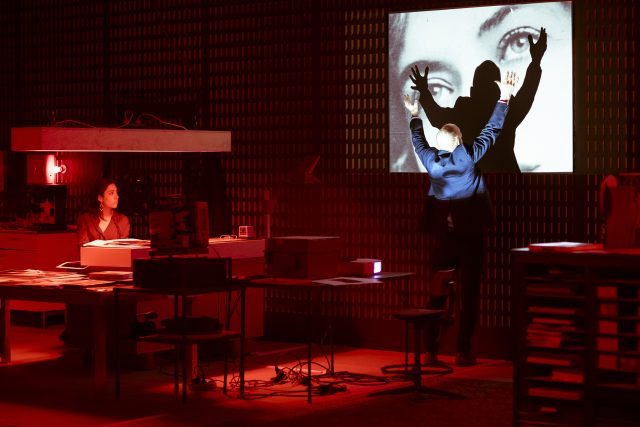
An older photographer (actor Wim van der Grijn) interacts with his imaginary younger self (tenor Andrew Dickinson) in Diary of One Who Disappeared (photo © Jan Versweyveld)
BAM Howard Gilman Opera House
Peter Jay Sharp Building
230 Lafayette Ave.
April 4-6, $28-$140, 7:30
718-636-4100
www.bam.org
www.transparant.be
A World War I–era song cycle inspired by an aging Czech composer’s infatuation with a young woman seems an unlikely subject for Ivo van Hove’s usual theatrical treatment, but the Belgian director and Flemish opera company Muziektheater Transparant have reinterpreted Leos Janáček’s Diary of One Who Disappeared in a quietly affecting sixty-five-minute production that is making its US premiere at BAM’s Howard Gilman Opera House this week. In the summer of 1917, the sixty-three-year-old Janáček began an eleven-year epistolary relationship with twenty-six-year-old Kamila Stösslová. Both were married; over eleven years, Janáček wrote more than seven hundred letters to her declaring his undying love, while Stösslová answered only intermittently, replying fewer than fifty times, and without Janáček’s intimate passion. Janáček used Stösslová as his muse; she inspired several of his operas and the song cycle Diary of One Who Disappeared. At BAM, the attractive set, designed by van Hove’s longtime partner, Jan Versweyveld, is a long, horizontal darkroom with photography equipment and a piano nearly hidden within a small bookshelf, behind which is a sleeping area; a low ceiling makes it feel like the performers are trapped in a mysterious diorama. The romantic story is told as a fantasy memory, as an older photographer (actor Wim van der Grijn) interacts with his imaginary younger self (tenor Andrew Dickinson), cast as a young farmer enticed into a torrid affair with a young Romany woman, Zefka (mezzo soprano Marie Hamard). (Janáček often referred to Kamila in his letters as a “black Gypsy girl.”)

Leoš Janáček’s Diary of One Who Disappeared gets the Ivo van Hove treatment at BAM (photo © Jan Versweyveld)
When the old photographer enters through a door in the back of the set, he is carrying an urn, the ashes of his late wife, and he admits he gave her only half his heart. He walks around the stage reciting lines from Janáček’s letters as Zefka and the younger man sing songs with lyrics taken from anonymous poems published in a 1916 newspaper. The lovely music is played by pianist Lada Valešová, with an offstage choir of Raphaële Green, Annelies Van Gramberen, and Naomi Beeldens contributing background vocals. Belgian composer Annelies Van Parys has added tender musical fragments that expand on Janáček’s themes.
The pacing is slow and genuine, with van Hove adding some of his signature multimedia touches, including live video of the two men developing a picture of Zefka, the use of an old-fashioned overhead projector, and footage of a naked woman beamed onto the actor’s body, as if she is deep within him. Versweyveld’s sensual lighting goes from cold blues to fiery reds. It’s a heartfelt story of unrequited love that spurred great creativity; inspired by Stösslová, Janáček also wrote Glagolitic Mass, Sinfonietta, and String Quartet No. 2 as well as characters in The Cunning Little Vixen, The Makropulos Affair, and Katya Kabanová. “I know that my compositions will be more passionate, more ravishing: you’ll sit on every little note in them. I’ll caress them; every little note will be your dark eye,” he wrote to her. It was an unrequited love that makes for a moving piece of theater.